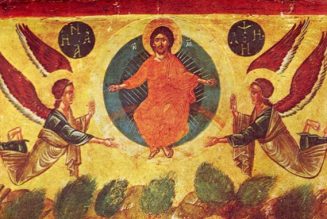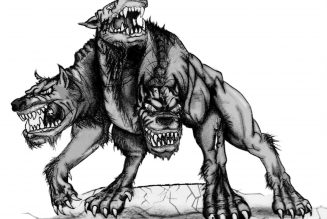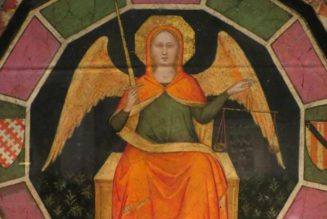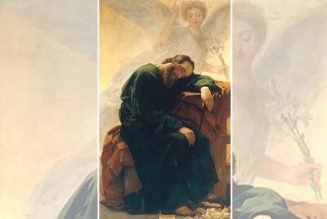By Dr. Jeff Mirus ( bio – articles – email ) | Jun 23, 2020 | In Scripture Series
Returning from a brief vacation, I find myself faced with St. John’s visions of the warfare between earth and heaven which characterizes the time remaining before Christ returns in glory. The Book of Revelation describes this in eschatological language—language which is symbolic of the battle between good and evil, God and Satan which fulfills and concludes our history. John is lifted up to heaven in a second vision, and he begins to learn of these things through the opening of seven seals which conceal the secrets of the times which lead up to the end. More visions follow, but here I will discuss the vision which introduces the seven seals themselves, as recounted in chapters 4 through 11.
Before we begin, let me offer an important caution. When interpreting the Book of Revelation, it is essential to keep St. Peter’s advice firmly in mind:
[D]o not ignore this one fact, beloved, that with the Lord one day is as a thousand years, and a thousand years as one day. The Lord is not slow about his promise as some count slowness, but is forbearing toward you, not wishing that any should perish, but that all should reach repentance. [2 Pet 3:8-9]
God is both outside of time and the Lord of time. Therefore, in eschatological literature all times tend to be fused together. The emphasis is on the eternal implications of what we on earth experience as a protracted battle, in which we seem to play only minor roles and have too little hope. The Book of Revelation offers not a chronological human history but successive snapshots of the drama of good and evil under the authority of Divine Providence. Moreover, everything is recounted in largely symbolic language. Therefore, rather than attempting to match particular human events to the drama revealed through the opening of each of the “seven seals”, we should recognize the spiritual implications of the text as God battles against evil to draw all men to Himself.
Key themes
It will be much easier to benefit from the spiritual lessons of the Book as a whole, and of the seven seals in particular, if we recognize three great themes in this series of chapters (four through eleven):
- The glory given to God in Heaven: St. John, when he is taken up (chapter 4), finds a place of constant worship of the Most High God, with a continuous singing of “Holy, holy, holy”, by the 24 elders (representing the twelve tribes of Israel and the twelve apostles), the four living creatures (representing the four evangelists), and the multitude of the heavenly host.
- The recognition of the Lamb of God (Christ, who was slain): It is the Lamb who holds the “scroll”—the mysteries of Divine judgement and the consummation of all things (chapter 5).
- The close connection between the saints on earth and those in heaven: Frequent references indicate that heaven is full of those who have suffered on earth for Christ, and that it is for the faithful on earth that God both limits His punishments and gives ample time for repentance and conversion—even though they suffer from the warfare and the delay.
It is the vision of the Lamb of God that sets the drama in motion, highlighted by one of the most famous passages in Scripture; for those before the Lamb “sang a new song”:
Worthy are thou to take the scroll and to open its seals, for thou wast slain and by thy blood didst ransom men for God from every tribe and tongue and people and nation, and hast made them a kingdom and priests to our God, and they shall reign on earth. [Rev 5:9-10]
Then all acclaimed the Lamb, thousands upon thousands, with a loud voice: “Worthy is the Lamb who was slain to receive power and wealth and wisdom and might and honor and glory and blessing” (Rev 5:12). Moreover, notice that John says he heard “every creature in heaven and on earth and under the earth and in the sea, and all therein, saying: ‘To him who sits upon the throne and to the Lamb be blessing and honor and glory and might for ever and ever!’” (Rev 5:13).
It is the Lamb that was slain that opens the seals.
Seals One through Six
The first six seals are dealt with quickly in chapter 6. The first four reveal the memorable “four horsemen of the apocalypse” who are sent to ravage the earth. The white horse signifies conquest; the red horse signifies the loss of peace on earth; the black horse, famine; and the pale horse, death (afflicting one-fourth of the earth). Seal five reveals those slain for God, who are ultimately protected under the altar. Seal six reveals cosmic chaos—a massive earthquake, stars falling from the sky, and people frantically hiding in caves in abject fear of the Lamb.
In chapter 7, the action of the seals is suspended, as it were. Four angels are told to hold back the four winds, with the revealing command: “Do not harm the earth or the sea or the trees, till we have sealed the servants of our God upon their foreheads” (7:3). Here the term “seal” is given a new meaning; it is a protection, to be sealed by the Lamb, in marked contrast to the “sign of the Beast” which comes later in the book. In any case, once again a number representing fullness is used to signify the elect: “And I heard the number of the sealed,” John writes, “a hundred and forty-four thousand sealed, out of every tribe of the sons of Israel” (7:4). One hundred and forty-four thousand (12 times 12,000) represents the immense number of those who will be saved, for John states:
After this, I looked, and behold, a great multitude which no man could number, from every nation, from all tribes and peoples and tongues, standing before the throne and before the Lamb, clothed in white robes, with palm branches in their hands, and crying out with a loud voice, “Salvation belongs to our God, who sits upon the throne, and to the Lamb”. [7:9-10]
One of the “elders” explains to John that these represent all “who come out of the great tribulation; they have washed their robes and made them white in the blood of the Lamb” (7:14).
The Seventh Seal
The opening of the last seal, in contrast to the others, is described at length, through the next four chapters. What it signifies is expressed in terms of seven angels with seven trumpets, with more revealed as each angel sounds his trumpet, and also three “woes”. In chapter 8, the first four trumpets are sounded, with these results: (1) Hail and fire with blood, destroying a third of the earth, a third of the trees, and all grass; (2) A burning mountain thrown into the sea, turning a third of the sea to blood, destroying a third of the sea creatures, and a third of the ships; (3) A star (which may indicate an angel) falling on a third of the rivers and fountains, turning a third of the water to wormwood; (4) A third of the sun, a third of the moon, and a third of the stars blotted out.
In chapter 9, the fifth angel sounds his trumpet, and a star falls to earth and is given the key to the bottomless pit (again, a star signifies an angel, this time Lucifer, of whom Christ said, “I saw Satan fall like lightning from heaven” (Lk 10:18)). Smoke darkens the sun and the air; horrible “locusts” (who serve the angel of the bottomless pit) are unleashed against all humans beings who lack the seal of God, and they endure a torture for “five months” (a limited time). This ends the first “woe”.
Then the sixth angel blows his trumpet, and the four angels who have been restrained are released to kill a third of mankind. Still, the rest
did not repent the works of their hands nor give up worshiping demons and idols…which cannot either see or hear or walk; nor did they repent of their murders or their sorceries or their immorality [again, in the NT this word refers to sexual sins] or their thefts. [9:20-21]
At this point, John receives a vision which serves as something of an interlude (chapters 10 and 11). He is given a “little scroll” to eat, which tastes sweet in his mouth but is bitter in his stomach—a Scriptural image of the urge to prophesy. He is commanded to reveal these things “about many peoples and nations and tongues and kings” (10:11) (which offers further evidence that the lessons are hard to apply precisely only to particular historical circumstances). John is then told to measure the temple of God—just the temple itself, for the nations will be given to “trample over the holy city for forty-two months” (this is a symbolic period described as “a time, times and half a time” (as in 12:14) or “a half week of years”—half of the perfect number seven—which signifies a significant but limited duration).
During this period—described, again, in very symbolic language—it is revealed that two olive trees and two lampstands (doubtless representing Israel and the Church) will fight against the beast from the bottomless pit and be killed, leading to great rejoicing among all who are evil. But after three-and-a-half days (again, half of seven, or a period of limited duration) they will arise and be called up to heaven. At this, a massive earthquake strikes, causing many to praise God. And now the second woe has passed.
Conclusion of this section
Immediately, the seventh angel sounds his trumpet. Again, the number seven indicates fullness or completion, and now we have the seventh angel in the opening of the seventh seal—thus, the climax. This ultimate fulfillment is announced by loud voices in heaven:
the kingdom of the world has become the kingdom of our Lord, and of his Christ, and he shall reign for ever and ever…. We give thanks to thee, Lord God Almighty, who art and who wast, that thou hast taken thy great power and begun to reign. [11:15, 17]
In all of this eschatological language of the seals, we have learned something of the drama of salvation, but we have seen only a little of the figures who are most centrally involved in it. Although it is the Lamb who opens the seals, the action of the book to this point has been orchestrated by unnamed angels. But with the sounding of the seventh trumpet by the seventh angel within the opening of the seventh seal, this changes decisively. We have come to the vision recounted in chapter twelve, where the “woman” and the “dragon” are revealed to us. Who are this woman and this dragon, and why are they so important? That will be the subject for the next installment on St. John’s Book of Revelation.
New Testament Series:
Previous: Apocalypse Now: The Book of Revelation, Part 1<!—
Next: Hebrews: Old covenant abolished; new covenant established.—>
Sound Off! CatholicCulture.org supporters weigh in.
All comments are moderated. To lighten our editing burden, only current donors are allowed to Sound Off. If you are a current donor, log in to see the comment form; otherwise please support our work, and Sound Off!

There are no comments yet for this item.










